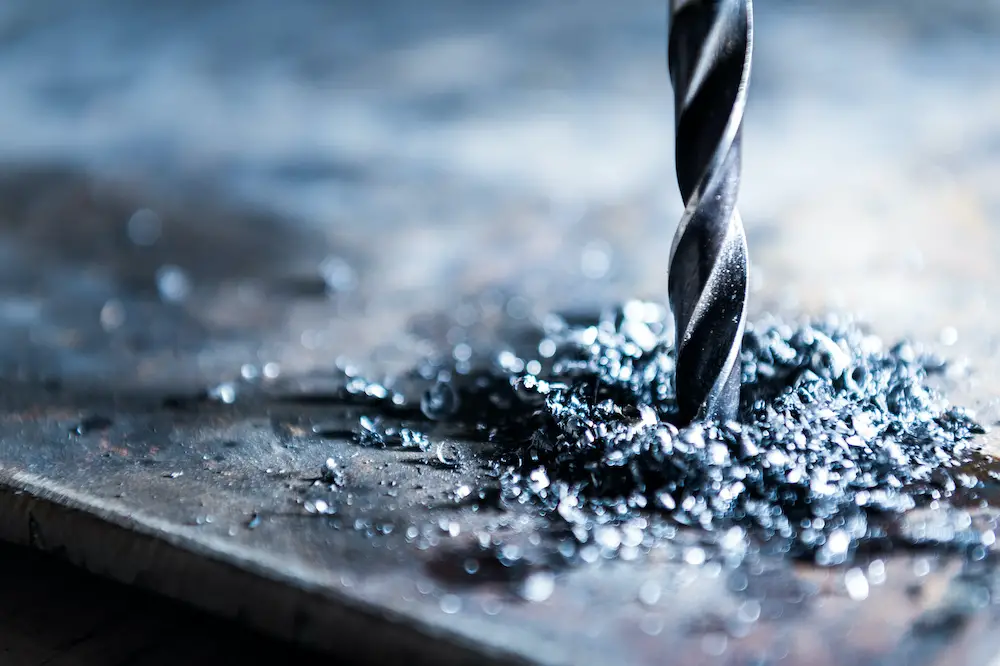With so many different drill bits available on the market and laying around in many toolboxes, it can be hard to know which types of drill bits are suitable for which materials.
Drill bits don’t always have clear labels since many have multi-purpose functionality, but this can make it hard to learn the difference between a metal drill bit vs wood drill bit.
There will be times when you need to use both drill bits during a single project.
Boat enthusiasts who are working on their own boats from plan to completion will find that metal and wood drill bits are both necessary at times, so having experienced with the differences between the bits will be very useful.
Today, we’ll cover the differences between these types of drill bits, including the areas where they overlap, as some drill bits can easily be for both materials, as well.
Metal Drill Bit vs Wood Drill Bit
Someone without much experience in using drill bits will look at wood drill bits and metal drill bits and have no idea which one is specifically for what materials, and that’s okay!
Drill bits all look very similar at first glance.
They sometimes come in the same sizes, shapes, colors, and more, so simply comparing their appearance is not always enough to gain an understanding of what those differences mean.
Plus, the differences can sometimes overlap in drill bits that are usable on both materials, such as twist bits.
The two primary ways that you can tell the difference between the two types, however, is through their color and their tip.
Color
Drill bits that are for both metal and wood come in various colors. The colors of the bits may be silver, copper, or another shade of metal.
Metal drill bits tend to be black, gray, or dark gray. You can determine the color by the coating on these bits.
Metal drill bits often have titanium or black oxide coatings. Wood drill bits, on the other hand, are typically silver.
Tip
The tip can be an easier giveaway on specialty drill tips that are specifically for wood or metal because it will be able to start cutting most efficiently.
For metal tips, this means that the tip will have a slight angle so that it can create the necessary force and tension to cut into the metal.
For wood tips, the tip might be a brad tip.
A brad tip has a very sharp, pointed tip that will immediately snag the wood so that the bit doesn’t move around while drilling.
Why the Differences Matter
If you’ve never used a drill bit on a material that it simply doesn’t work on, you might be wondering why it matters which type of drill bit you use on which material.
Essentially, the primary issue that you will encounter when mixing up these drill bits is the risk of breaking the drill bit permanently or damaging the material that you are trying to drill through.
In some cases, the drill bit will appear to work just fine, though.
Still, even if the drill bit appears to have worked, it may have become damaged or caused structural damage to the material that you are working on.
As such, it is best not to risk that if you can avoid it.
Metal Drill Bit on Wood
If you use a drill bit specifically designed for use on metals when drilling wood, there is a good chance that you will cause the wood to splinter, crack, or even fully split.
Generally speaking, metal tips are able to withstand much stronger forces than wood tips, so the power might be too much.
That, of course, is going to depend on what type of wood you are using, as well as the particular metal tip.
Regardless, it is a risk that you should keep in mind.
Wood Drill Bit on Metal
Using a wood drill bit on metal is more likely to cause damage to the drill bit than it is to cause damage to the metal.
Still, it is possible to scratch or damage the metal in the process.
The wood drill bit may strip or break as you try to drill through the metal because it does not have the right tip or cutting edge to make a smooth cut through such a hard material.
By using the right drill bit, you’ll make your project easier to complete and also extend how long you can use your drill bits by not damaging them unnecessarily.
Get Organized With the Best Boat Plans
When working with a lot of different materials as well as a variety of drill bits, the only way to keep things straight and avoid creating unnecessary damages is to stay organized.
Boat lovers looking to build a boat might find this very hard to do because there are so many steps to consider, tools to work with, and materials to sort through.
Organizing them all could be a nightmare if handled incorrectly. This is where incredibly reliable and detailed boat plans could make all the difference.
Clear pictures, follow-along video tutorials, and detailed step-by-step guides for more than 500 boat variations erase that worry.
There are simple and easy steps for the entire process so that even those who are still having trouble with figuring out the difference when it comes to a metal drill bit vs wood drill bits will be able to succeed.

Best Drill Bit Types for Wood
Let’s focus in on what you might need when you’re working with a wood project.
Many boat projects are primarily revolving around wood, so understanding what types of drill bits are effective when working with wood is a must for every boat building enthusiast.
Even those who aren’t building boats will want to stock up on the different bit types and sizes that are most common for daily projects.
The following information will help get you on that path.
1. Spade Wood Bits
The first type of wood drill bit that is very common is the spade bit.
Sometimes, these drill bits goes by the name flat or paddle bits, but all three refer to the same type of drill bit that is wood-friendly.
Spade bits are great when you need to quickly drill a large hole without risking any splitting or splintering in the wood.
Thought the spade bit is mostly flat, the tip of the drill bit still has a pointed tip.
This pointed tip is important because it is what grabs the wood and keeps the bit in place while you are drilling to prevent any slippage or walking.
2. Brad Point Bits
Another type of wood bit that people usually use is the brad point tip. This type of bit is commonly referred to as a twist bit.
Brad point bits are a specific type of twist bit. The shaft has a corkscrew design, the guides that create a guide for screws to enter the hole after drilling.
The tip of these drill bits has a brad point, which grabs the wood and secures the drilling position.
3. Countersink Bits
The final type of common wood bits is the countersink bit.
Countersink bits are a special kind of drill bit that allows you to create a hole that a screw will be hidden inside of.
Once the hole is finished and covered again, the screw won’t take away from the final look of your boat or whatever project you are using the countersink bit for.
Best Drill Bit Types for Metal
While there are dozens of different types of wood drill bits on the market, there are markedly fewer different types of metal bits.
Still, there is some variation between types that is worth being mentioned so that you can easily determine which is going to be best for your projects.
1. HSS Bits
HSS or high-speed steel bits are one of the most common types of drill bits used for any material.
Depending on their size and the materials they’re made of, HSS drill bits can be made to be used on metal, plastics, masonry, wood, and more.
Because these bits don’t typically have a brad point, they can split softwoods.
These drill bits can cut through metal smoothly, though, and that is what makes them a popular choice.
2. Coated HSS Bits
A similar type of bit that is very popular for metal is durable HSS bits.
These are made from carbon steel and coated with a protective finish, which can either be titanium or black oxide.
Basic HSS bits are only made for lightweight materials, like thin metal or aluminum.
Stronger materials will require HSS bits that have a stronger finish.
Conclusion
Armed with the best boat plans around, as well as important knowledge about how to differentiate between different drill bit types, you will be able to successfully start your boat project.
If you’re not ready to start something quite that large yet, these tips about drill bits are still helpful just for doing simple handiwork around the house.
Using the correct drill bits while working makes a huge difference in the long-term durability of your tips as well as how easily you can complete your tasks.
Pay attention to what drill bit you use, and you’ll learn these differences more intricately in no time.

If you like this article, check out Boat Diaries’ blog section for anything and everything boating. Happy sailing!


